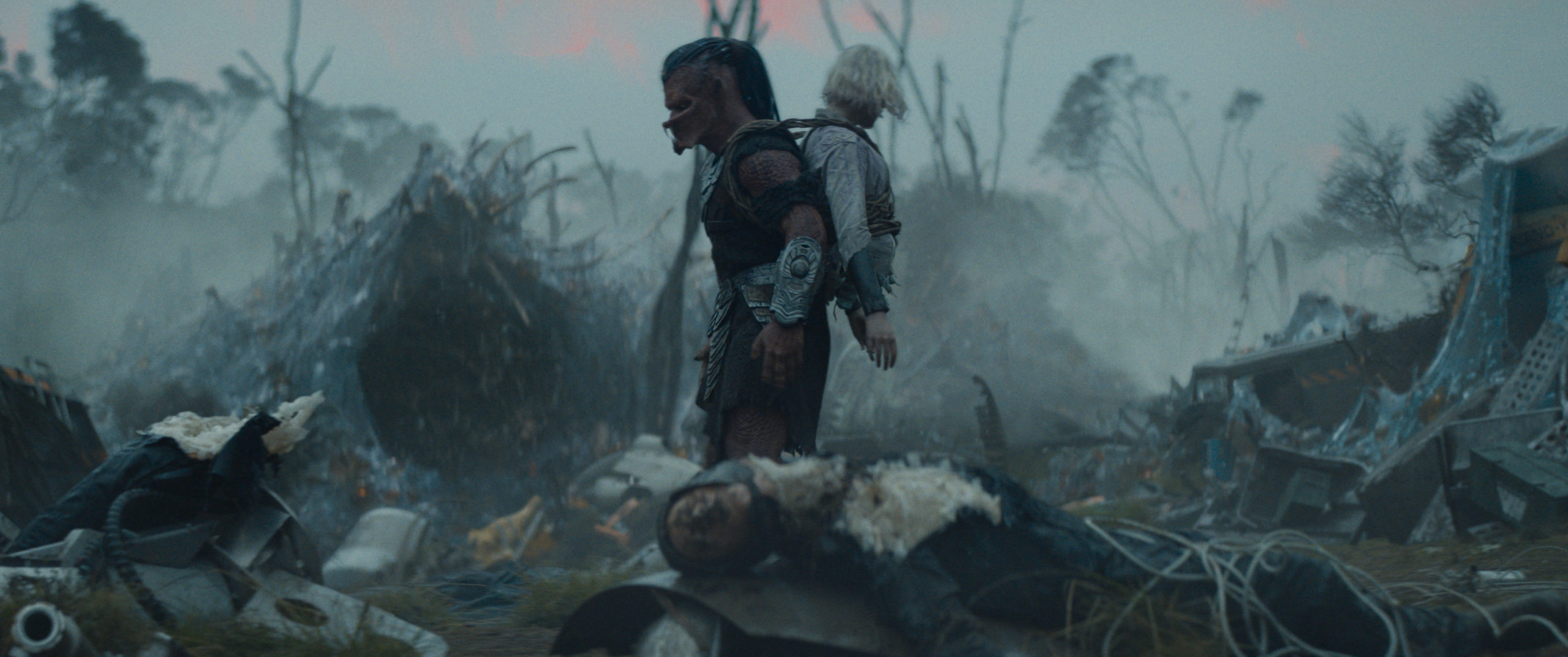
Director Dan Trachtenberg's Predator: Badlands is a bold reinvention of the franchise, shifting the perspective to a Yautja outcast, Dek.
By DANIAL FUAD
The Predator franchise finally lets us walk in the mandibles of the hunter and it’s a profound, brutal walk. Director Dan Trachtenberg’s latest entry, Predator: Badlands, which is now showing in Malaysian cinemas, is a bold, lore-expanding film that completely shifts the perspective of the Yautja species. Centred on the exiled young warrior Dek (Dimitrius Schuster-Koloamatangi,) the film follows his desperate mission to hunt the legendary Khalisk on the lethal planet Genna to prove himself to the clan.
This narrative shift uses its savage alien setting to explore fascinating, human themes. Badlands succeeds as both visceral action cinema and a surprising meditation on vulnerability, adaptability, and the corporate hunt, carving a necessary and powerful new direction for the forty-year-old franchise.
The Predator as Protagonist

Trachtenberg breaks the mould by focusing on a Yautja protagonist, giving us unprecedented insight into their warrior culture. As the director himself noted, this is the first time “we’re following the monster.” Dek’s arc is defined by the toxic rigidity of his clan, particularly through the eyes of his father, the chief, who views him as what Trachtenberg calls the “runt of the litter.” We learn that Yautja social standing is predicated on an unforgiving code of strength, tragically demonstrated when Dek’s own brother sacrifices himself to defend him from their father’s wrath.
This internal conflict is key: Dek must reconcile his desire to prove his Yautja worth with the understanding that true strength is not just genetic dominance but earned adaptability and connection. The film eloquently argues that sometimes, the outcast can be the ultimate survivor.
Unlikely Partnership
The emotional core of this brutal odyssey is the unlikely partnership between Dek and the synthetic Thia (Elle Fanning.) Trachtenberg made a conscious choice to avoid human characters, stating, “as soon as we put a human in, we’re all going to be drawn to them… maybe this is a beautiful movie about a monster and a robot.” This gamble pays off. Their interactions quickly evolve from a transactional arrangement where Dek viewed her as a mere “tool” to genuine kinship.
The dialogue, spaced out by moments of brutal violence, provides surprisingly effective comedic relief, creating a warm, buddy-movie energy. By the film’s conclusion, Dek can transcend his clan’s emotional repression, daring to call Thia and the child of Khalisk his family. This dynamic injects the Predator universe with a much-needed layer of heart, reinforcing the idea that survival often requires collaboration, a concept antithetical to the Yautja creed.

Adaptability is Key
The hostile environment of Genna is utilized not just as a backdrop, but as a crucial narrative mechanism enforcing the central theme of adaptability. With his advanced Yautja gear initially lost when his ship crashed, Dek is stripped down to raw instinct. He is forced to study the local flora and fauna, using the vicious alien plant life and scavenged resources as necessary weapons and tools. This survival mechanic directly challenges the rigid hunting doctrines passed down by his clan, reinforcing the idea that old ways must yield to situational intelligence for survival.

Furthermore, Badlands cleverly integrates the universe’s ultimate threat: the Weyland-Yutani Corporation. This is where the film’s social commentary sharpens. By showing that the corporation is actively hunting and exploiting the local flora, especially the Khalis and even the Yautja, turning Dek into a test subject upon capture, the film establishes that not even the galaxy’s most apex hunters can escape being the prey of corporate greed. Weyland-Yutani’s scientific, soulless ambition serves as a powerful thematic mirror to the Yautja’s savage, ritualistic hunting, suggesting that the drive for profit and bio-weaponry is the most dangerous “predator” of all.
Family by Choice
The film also masterfully explores the concept of family by inverting the traditional proverb. While “blood is thicker than water” has long been used to prioritize birthright, Badlands champions a powerful modern counter-proverb: “the blood of the covenant is thicker than the water of the womb.” This phrase, which argues that chosen bonds (covenant) are stronger than birth family (womb,) is the film’s thematic heartbeat.
The film makes this point with brutal clarity. Dek’s own father, driven by toxic clan law, kills his other son without remorse. Similarly, Thia is betrayed by her so-called ‘sister,’ the cold and calculating synthetic Tessa. These betrayals by “blood” stand in stark contrast to the “covenant” of loyalty forged between the two outcasts, Dek and Thia, reinforcing that true family is not a matter of birth, but of a shared bond.

Technical Execution & Spectacle
On a technical level, Badlands is a triumph. The fight scenes are exceptionally well-choreographed, eschewing the chaotic shake-cam often seen in action sci-fi for clean, intense sequences. You feel the impact and weight in every strike. The film is studded with what can only be described as “aura farming” moments with visual feasts that instantly become iconic trophy-kills, such as the protagonist splitting a bone bison in half with a perfectly centered blade strike.
This is made possible by a revolutionary approach to the Predator itself; for the first time, the character is unmasked for most of the film. Actor Dimitrius Schuster-Koloamatangi filmed with an open cowl, allowing Wētā FX to capture his full range of facial expressions and integrate them into the creature’s design, giving Dek a visible, relatable humanity previously unseen beneath the mandibles.

The visual design is equally praiseworthy, from the detailed Yautja equipment to the sleek, menacing Weyland-Yutani tools. More impressive, however, is the scale of the world-building. By shooting in the “incredible landscapes” of New Zealand, Trachtenberg creates a “tactile” and “otherworldly” setting. Expertly crafted establishing shots convey the vastness and lethality of the planet Genna, often framing Dek as a tiny, vulnerable figure against an overwhelming alien landscape.
This constant reminder of the planet’s scope which recalled back the awe-inspiring panels of Netero’s journey into the Dark Continent in Hunter x Hunter underscores how insignificant the characters are, intensifying the stakes of their personal struggle.
The Flawed Conclusion

While the film is a bold success, its narrative conclusion suffers from one significant weakness. Dek’s central mission in obtaining the Khalisk’s head to reclaim his honor abruptly shifts when he eventually delivers the head of the Weyland-Yutani synthetic, Tessa, instead to his father. This pivot lacks the necessary emotional foundation.
While the intent is clearly to show Dek choosing found family over his clan’s toxic code, the film fails to adequately build the connection or significance of Khalisk to justify Dek’s change of heart. The emotional impact of the ultimate sacrifice and the switch in objectives feels unearned and sudden, slightly undercutting the payoff of Dek’s season-long emotional evolution.
A New Direction

Predator: Badlands is a powerful, compelling, and necessary reinvention of the franchise. By shifting the perspective to the Yautja outcast and infusing the journey with themes of corporate malice and humanistic connection, the film achieves a rare depth for a blockbuster. It is bold, heartfelt, and ultimately, proof that the best way forward for the Predator franchise is to continue looking inward. Dek’s journey of vulnerability and adaptation leaves a lasting impression, fulfilling Trachtenberg’s goal for audiences to “form a connection to these characters… you would never ever expect to love.”
Follow other interesting article on BASKL by clicking on the link below:
